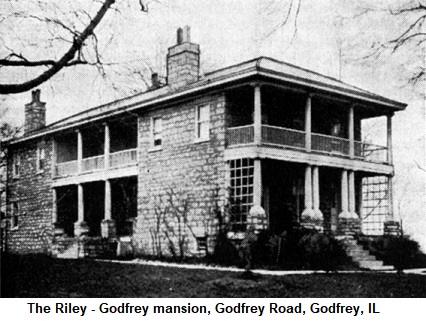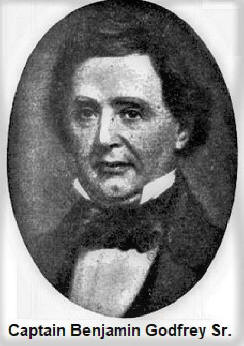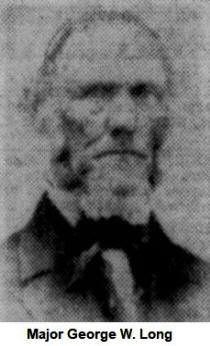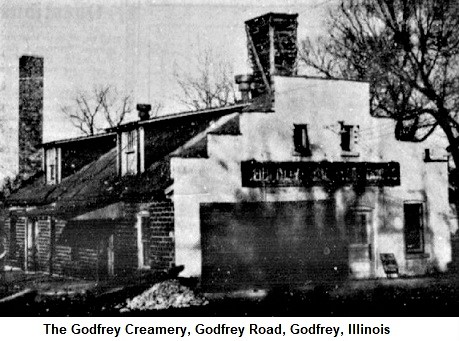Early History of Godfrey (Scarritt's Prairie or Monticello)
Settlers on
Scarritt’s Prairie
Nathan A. Scarritt was born in 1788 in Connecticut. His parents were
Nathaniel Scarritt (born in 1757, and was possibly a Revolutionary
War soldier) and Abigail Atkins Scarritt (?-1840). Nathaniel and
Abigail had the following children: Lucy Scarritt Moore (1781-1841);
Rev. Isaac Scarritt (1783-1861, who was a preacher of great ability
who died in Joliet, Illinois); Nathan A. Scarritt (1788-1847);
Jeremiah Scarritt (1793-1811); and Lovina Electa Scarritt
(1801-1863, who is buried in the Bethany Cemetery in Godfrey).
Nathan A. Scarritt married Latty Allds on April 02, 1812. In 1820,
they moved by wagon from New Hampshire to Illinois, locating first
at Edwardsville. They lived in Edwardsville for a short time, then
found their way to the Illinois prairie in 1826, locating on what
was later named Scarritt’s Prairie in Godfrey Township. Scarritt’s
Prairie encompassed all the territory east of present-day Godfrey
Road, and north to the Madison County line. Nathan was the first to
cultivate the ground in the area, although the first cabin was built
and occupied by Joseph Reynolds. He built the first brick home on
Scarritt’s Prairie, and lived the rest of his life farming the land.
The first religious services in Godfrey Township were held in his
home, and the first school was taught in his barn, with his daughter
teaching approximately sixteen students. Jotham and Latty had twelve
children. Among them were Isaac Scarritt (born 1817); Nathan
Scarritt Jr. (born April 14, 1821 in Edwardsville, and who married
Martha M. Chick, daughter of William Chick, one of the founders of
Kansas City); Jotham A. Scarritt (who was born on Scarritt’s Prairie
on June 23, 1827); Winthrop Scarritt; and at least two daughters –
Laura Scarritt and Mary Jane Scarritt. It was in the Scarritt home
that the Methodist Church in Godfrey, called Bethany Society at the
time, was organized in 1827. Nathan Scarritt died in December 12,
1847, and was probably buried in the Bethany Cemetery, located at
Bethany and Humbert Road. His obituary simply stated, “he walked
with God in all the duties of a faithful Christian, a kind presence,
a good neighbor, and citizen.” His wife, Latty Scarritt, died in
December 1875, and was buried in Bethany Cemetery on Scarritt’s
Prairie.
Joseph Reynolds built the first cabin in Godfrey Township, and sold
the cabin to Samuel Delaplain. Other early settlers of Scarritt’s
Prairie included Henry P. Rundle Simon Peter, James Dodsen, Hail
Mason, Joel Finch, Zebedee Chapman, Ezra Gilman, and Rowland and
Oscar Ingham. Later came John Peter, George Smith, John Mason,
Zebedee Brown, James Meldrum, Richard Blackburn, Henry Waggoner,
Samuel Waggoner, David Rood, and Joseph Whyers – all settling on the
east side of the prairie.
Hail Mason became a resident of Madison County as early as December
1817, living in Edwardsville with his brothers, James and Paris
Mason. From Edwardsville, Hail Mason moved to Clifton for a year or
two, then made his home on Scarritt’s Prairie. His house was a short
distance northeast of the future town of Godfrey. He served as
Justice of the Peace. His brother, John Mason, settled on a farm a
short distance northeast of Godfrey. His two sons, Aaron P. and John
Mason, were residents of Godfrey for many years. John Mason died in
1880.
The
Riley – Godfrey Mansion
The first improvement on the property that became the residence of
Captain Benjamin Godfrey was made by Calvin Riley, who accompanied
Judge Webb to Illinois from the State of New York. He was the
brother of the Captain
 Riley
who endured a captivity in Africa, and published a book known as
“Riley’s Narrative.” Calvin Riley built a stone house, which was
purchased by Captain Benjamin Godfrey, and with additions made by
Godfrey, became the beautiful resident in which he raised his
family. Captain Riley engaged in the mercantile business in Alton,
and then moved to Edwardsville for one year. He returned to Godfrey
Township to farm. He met his death in Michigan while on a fishing
excursion. The first house south of the Godfrey home was built by
Captain Riley, where George T. M. Davis lived for a time. It was
afterward occupied by James Hamilton, who kept it as a hotel named
the Star Hotel. Hamilton was one of the workmen who came from the
East to help build the Seminary. The Star Hotel was destroyed by
fire October 23, 1862.
Riley
who endured a captivity in Africa, and published a book known as
“Riley’s Narrative.” Calvin Riley built a stone house, which was
purchased by Captain Benjamin Godfrey, and with additions made by
Godfrey, became the beautiful resident in which he raised his
family. Captain Riley engaged in the mercantile business in Alton,
and then moved to Edwardsville for one year. He returned to Godfrey
Township to farm. He met his death in Michigan while on a fishing
excursion. The first house south of the Godfrey home was built by
Captain Riley, where George T. M. Davis lived for a time. It was
afterward occupied by James Hamilton, who kept it as a hotel named
the Star Hotel. Hamilton was one of the workmen who came from the
East to help build the Seminary. The Star Hotel was destroyed by
fire October 23, 1862.
Captain
Benjamin Godfrey
Captain Benjamin Godfrey was born at Chatham, Massachusetts on May
20, 1794. His early life was mostly spent on the sea. It is said he
began the life of a sailor when only nine years old, however he
acquired a good practical education and knowledge of navigation.
When a boy, he spent some months in Ireland, and was connected with
mercantile service during the War of 1812. He afterward became
Commander of a merchant vessel, and made

The Village of
Monticello (Godfrey)
The village of Monticello was laid out by Captain Benjamin Godfrey
and Enoch Long. The town plat was recorded May 30, 1840. The name
was changed to Godfrey when the post office was established in 1841.
Early
Businesses in Godfrey
The first store in Godfrey was opened by Timothy Turner. Turner was
the first postmaster, being appointed to that position in 1840.
Turner resigned the office in 1860 due to old age, and Thomas P.
Walworth, his former clerk, took over as postmaster. Walworth held
the position for a short time, and was succeeded by Benjamin
Webster, who was postmaster from 1861 to 1881, when he was succeeded
by Edward A. Mason. The brother of Timothy Turner, Charles E.
Turner, married the granddaughter of Captain Benjamin Godfrey – Cora
E. Godfrey Turner.
There were two grocery stores in Godfrey kept by Edward A. Mason and
John F. Boyd. George Churchill operated a dry goods and grocery.
John Roberts operated a restaurant, and a blacksmith and wagon
making shop was carried on by Aaron C. Mason and T. Baldwin. Later,
this was operated by Mark Robidou and the firm of Wirth & Weber. X.
Maier and Carl Wenzel operated shoe shops. A flour mill was built in
Monticello in 1857 by Henry and Uriah Howell, who sold it to Richard
Blackburn. Blackburn died three years afterwards, and Sears &
Dodgson took over the mill. This mill was later moved to Clifton,
where for a time it was operated as a cement mill.
The Godfrey Creamery was located on the west side of Godfrey Road,
near Pearl Street. In 1893, Frank J. Rue and Herman D. Bull owned
the creamery, and sold it to Joseph Blonde. In 1915 brothers Roy R.
and Mortan Pattison operated the creamery, and named it “Golden
Rod.” The “Golden Rod” butter was their specialty, which was shipped
to Alton, East Alton, Bethalto, Wood River, and beyond. By 1941 the
creamery closed, and in 1944 the village of Godfrey purchased the
property and converted the building into the town hall/fire
department.
Early Schools in
Godfrey
The first school in Godfrey Township was taught in the barn of
Nathan Scarritt on the “Brighton Road” (Humbert Road). His daughter,
Laura, served as its teacher, with sixteen students. A school was
also taught in the years 1829 – 1831 at the residence of George
Debaun, near what was later the South Branch School on Highway 67
(Godfrey Road). Abigail Scarritt and Elizabeth Peter were the
teachers. In about 1832 or 1833, a school was established at the
Bethany Church, near the intersection of Bethany and Humbert Road.
For some years, this was the only school in the township. A West
Point cadet by the name of Johnson taught this school in 1839.
Elijah Frost took charge of the school in 1840 and taught there for
three years. Pupils came to attend this school from Clifton and
Jersey County, which bordered to the north. Subsequent teachers were
Mrs. Russell Scarritt, Mary Jane Scarritt (the youngest daughter of
Nathan Scarritt), and William Cunningham.
A three-room schoolhouse was constructed in about 1843 on the
hillside on Godfrey Road, on the north side of the present Godfrey
Cemetery. The principal was James Squire, with Fannie A. Burgess as
assistant. The basement of the school served as classrooms for the
African - American children. J. M. Anderson was in charge of that
school. During the Civil War, the school was the meeting place of
Northern sympathizers called the Union Leaguers. A group of Southern
sympathizers, who had their headquarters on Piasa Creek to the
north, threatened to show up and cause physical harm. The Union
Leaguers were well prepared, but the Piasa Creek boys failed to make
their appearance. In the Fall and Spring, students would sit on the
steps between the schoolyard and the Godfrey Cemetery next door.
Occasionally the students could hear through open windows the sound
of gravediggers digging a fresh grave. The older boys and girls
would frighten the younger ones by telling them the water which ran
into a nearby well from which they drank ran over the dead bodies in
the cemeteries. This school was in use until 1910, when it was
destroyed by fire. A two-room temporary school was quickly erected
in its place. After much discussion, Edward Wade, an Alton banker
and trustee of Monticello Female Seminary, agreed to sell a corner
of its property for a schoolhouse for $1500. The home on the
property was sold and moved to Humbert Road. A new brick schoolhouse
was completed in 1912 and was located just to the south of the
cemetery. An addition was made in 1937.
Early Churches
in Godfrey
Early religious services were held at the home of Nathan Scarritt,
and there the first sermon was preached in the summer of 1828 by
Rev. John Hogan, a Methodist minister. Mr. Hogan was then operating
a mercantile business at Edwardsville, and subsequently became a
resident of Alton, and afterwards St. Louis.
A Methodist class was organized at the time of settlement in
Godfrey, but not regular church organization existed until 1842.
The Bethany Church
Founded in 1827 by Nathan and Latty Scarritt, the Bethany Society
met at the Scarritt home, and then in a small frame schoolhouse at
the northeast corner of Bethany Lane and Humbert Road.
On December 26, 1842, the official Bethany Church was organized. Among the
original members were Hail Mason, Nathan Scarritt, Josiah Randle,
Simon Peter, James Meldrum, John Mason Jr., Aaron P. Mason, Richard
Blackburn, Elijah Frost, David Rood, and William Squire. Simon Peter
donated the land on which the church building was constructed in
1851. The Randles, Scarritts, and others were supporters of the
Methodist Church, and it was customary for them on Wednesday nights
to drive around the neighborhood in a big wagon, collecting a good
number of people to go to Upper Alton and attend the weekly class.
The Bethany Church constructed subsequent buildings in Godfrey as
the congregation grew.
The Church of Christ
The Church of Christ in Godfrey was organized on November 02, 1839,
with twenty-six members. At the first meeting, of which the Rev.
Theron Baldwin (first principal of Monticello Female Seminary) was
moderator, a constitution, confession of faith, and covenant were
adopted. Timothy Turner and Benjamin I. Gilman were appointed
elders. Rev. Theron Baldwin was installed pastor of the church on
November 22, 1840. Abijah W. Corey was appointed elder in October
1841. Captain Benjamin Godfrey, who had united with the Alton
Presbyterian Church in 1833, became a member of the church at
Godfrey in 1844, and on October 5 of that year was appointed an
elder. In the fall of 1842, a large addition was made to the church.
Rev. Elisha Jenny was at that time taking the place of the pastor,
who was absent in the East. In the spring of 1844, the Rev. Mr.
Baldwin resigned as pastor, and Rev. George Pyle took over from that
time until 1846. This church was built at the joint expense of the
congregation and Monticello Seminary, on land belonging to the
Seminary. The church was organized on an independent basis, and not
connected with any denomination. Members were Presbyterian, Reformed
Dutch, and Congregational. In 1854, the church became strictly
Presbyterian, and united with the Presbytery of Alton. In 1867, the
church withdrew from the Presbyterian connection and returned to its
original independent basis.
The Baptist Church
The Baptist Church, on the south side of Godfrey, adjoining North
Alton, was built in 1858. Rev. Mr. Bevins was pastor in 1882.
BETHANY
Bethany was a small settlement located on Scarritt’s Prairie
(Godfrey), at Bethany Lane and Humbert Road. Nearby was the
homestead of Nathan Scarritt and the Masons. The Bethany Methodist
Church was founded there, and a building erected for worship.
Charles Henry Mason donated land in Bethany for a schoolhouse, which
was named Mason School.
Read Bethany
newspaper articles here.
COAL BRANCH
Coal Branch was a small mining settlement located in the southern
portion of Godfrey Township, near the border with Alton Township.
Coal Branch was settled near the Coal Branch creek by coal miners.
There was one store, owned by John and Hugh Pierce. Coal was mined
by Joseph and Richard Whyer at an early date. They supplied the
first coal used in the Alton State Penitentiary. The first pit was
opened by James Mitchell in the summer of 1848. A few months later
another pit was sunk by Thomas Dunford. Other coal miners included
Dennis Noonan, Peter Robinson, Charles Crowson, William Watts, Henry
Camp, Peter Taylor, Nathan Sydel, Henry Conlon, and John Rutledge.
The coal was of superior quality, but the vein had only a thickness
of thirty inches. The shafts ranged from fifty to one hundred and
twenty feet in depth. Following the opening of the Chicago & Alton
Railroad, considerable quantities of coal were shipped to
Springfield, Bloomington, and Chicago. The vein is now exhausted.
In 1882, Coal Branch had one store, two blacksmith shops, and a few
other business establishments. In the early days, a flour mill owned
by Mr. Whyer stood at Coal Branch. David R. Jones established a hall
and grocery at the corner of Elm and Alby Streets in Coal Branch. He
and his family lived upstairs.
James Mitchell of Coal Branch
James Mitchell was born in Scotland on December 21, 1811 to parents
Robert and Mary Mitchell. Robert Mitchell was determined to better
himself, so he sought an American home, bringing with him his family
of eleven children and three hundred colonists. James was the
oldest. On July 4, 1829 they landed at Pictou, Nova Scotia. Not
satisfied with Nova Scotia, they immigrated to America and made
their way in 1834 to Pottsville, Pennsylvania. In 1835, James made
his way to the salt works in West Virginia, and then to Kentucky and
New Orleans, learning the coal mining trade. Returning to Nova
Scotia, he met and married Mary Smith, a native of the Island of
Cape Breton. Soon after, he returned to the States, settling in
Missouri, and in 1848 settled in Madison County, Illinois. He opened
the first coal mine in Coal Branch. By his first wife he had eight
children. She died October 4, 1857, and James re-married Margaret
Bird on November 3, 1857. Mitchell was largely responsible for
developing the coal industry in the area. James Mitchell died May 1,
1889, and is buried in the Upper Alton Cemetery.
Early Church of Coal Branch
In 1859 a church was formed at Coal Branch from the Baptist mission
school in Hunterstown (Alton), by seventeen members (including
Thomas Dunford and wife, and Robert Mitchell and wife). A house of
worship was soon built on the land of Thomas Dunford, a pastor
secured, a Sabbath school organized, and a good congregation
gathered. Soon after, several from Coal Branch were baptized, and on
March 21, 1859, the church was organized with 17 members. Rev. H.
Gallagher, then a student in Shurtleff College, served as pastor for
a considerable period. After Mr. Gallagher’s pastorate, greater
prosperity was attained under the pastorate of Rev. Mr. Place. Then
the darkest period of the church came under the Rev. Mr. Austermel,
when the church became almost extinct. Joseph Bevan, a student in
Shurtleff College, then begin to preach at the church, and
prosperity was enjoyed once again.
Read Coal
Branch newspaper articles here.
MELVILLE
Melville is located less than a mile from Clifton in Godfrey
Township, on Rt. 3 (or West
Delmar). In 1882, there were about half a dozen houses located
there. Mrs. Louis Schmidt had a small store and was in charge of the
post office. A distillery was operated at Melville at an early date.
There was a Congregational Church (now Harmony Baptist Church), with
a cemetery next door.

